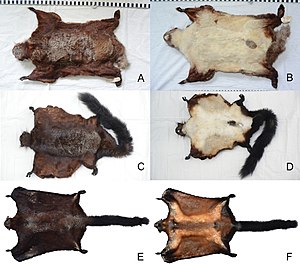Gaoligong flying squirrel
| Gaoligong flying squirrel | ||||||||||||
|---|---|---|---|---|---|---|---|---|---|---|---|---|

Skins of the three known Biswamoyopterus species, in the middle the Gaoligong flying squirrel |
||||||||||||
| Systematics | ||||||||||||
|
||||||||||||
| Scientific name | ||||||||||||
| Biswamoyopterus gaoligongensis | ||||||||||||
| Quan Li , Xue-You Li , Stephen M. Jackson , Fei Li , Ming Jiang , Wei Zhao , Wen-Yu Song , Xue-Long Jiang , 2019 |
The Gaoligong flying squirrel ( Biswamoyopterus gaoligongensis ) is a species of the flying squirrel and the third known species of the genus Biswamoyopterus . It is only known of two specimens that were caught in Gaoligong Shan in China in 2017 and 2018 and scientifically described in 2019 .
features
The Gaoligong flying squirrel is a relatively large flying squirrel and has a head-to-trunk length of 44.0 cm, a tail length of 52 cm and a weight of around 1.4 kg. Like all flying squirrels, the animals have a well-developed sliding membrane (patagium) between the legs and the tail. The tail skin ( uropatagium ) takes up about a third of the tail. The back color and the upper side of the sliding skin are predominantly reddish brown, while the back between the shoulder and the tail sliding skin is speckled white. This mottling is absent on the head, shoulder, the sliding arm skin ( plagiopatagium ) and the outer edge of the sliding tail skin as well as on the limbs and the tail. The shoulder and head are also reddish brown, the top of the head is yellowish gray. The ears are hairless and have two bundles of long hair as tufts at the base. The front tufts are black and the rear ones are white at the base and black at the tip. The tops of the hands are reddish brown and the fingers are black while the feet and toes are completely black. The tail is cylindrical in cross section, the part behind the base Uropatagium is black. The part inside the uropatagium is the same color as the uropatagium. The throat, abdomen and the underside of the abdominal surface of the patagium are yellowish white, but the scrotum is dark brown and contrasts accordingly with the peritoneum.
The skull is large with a short snout and widely spreading zygomatic arches . The timpani are relatively large. From the two already known species of the genus, the Laos flying squirrel and the Namdapha flying squirrel , the Gaoligong flying squirrel differs mainly in its coloration and some skull features.
distribution
The two animals used for the initial description of the species were captured in Gaoligong Shan in Yunnan , China . Both the holotype and the paratype come from the Longyang district of the city of Baoshan on the border with Myanmar . In addition, the species was documented photographically from Linjiapu and Banchang , which are each a few kilometers from where the types were found.
Way of life
Very little information is available about the species' way of life. The habitat of the animals is in the evergreen deciduous forest at an altitude of about 2,000 meters. Photos were used to document that an animal was resting in the branches of Daphniphyllum . In addition to Biswamoyopterus gaoligongensis , various other species of flying squirrel live in the region, including the Yunnan giant flying squirrel ( Petaurista yunanensis ), the spotted giant flying squirrel ( Petaurista elegans ) and the black and white flying squirrel ( Hylopetes alboniger ).
Systematics
The Gaoligong flying squirrel belongs to the tribe of flying squirrels (Pteromyini) in the squirrel family (Sciuridae) and is assigned to the genus Biswamoyopterus . It was in 2019 by a working group led by the Chinese zoologists Quan Li from gaoligong mountains in Yunnan , China , described . After the Namdapha flying squirrel ( Biswamoyopterus biswasi ) described in 1981 from the northeast Indian state of Arunachal Pradesh and the Laos flying squirrel ( Biswamoyopterus laoensis ) described from Laos in 2013, this was the third species of the genus.
No subspecies are distinguished within the species.
Existence, endangerment and protection
At the IUCN , the Gaoligong flying squirrel has not yet been recorded at the time this article was written (August 2019). The limited information available on the species suggests that it is rare. The forests in which the species lives are at low altitude and close to human settlements, making them likely to be vulnerable to human activity. The threats currently known are the conversion of habitats into agricultural land and potential poaching.
supporting documents
- ↑ a b c d e f g h Quan Li, Xue-You Li, Stephen M. Jackson, Fei Li, Ming Jiang, Wei Zhao, Wen-Yu Song, Xue-Long Jiang: Discovery and description of a mysterious Asian flying squirrel (Rodentia, Sciuridae, Biswamoyopterus) from Mount Gaoligong, southwest China. In: ZooKeys. Volume 864, 2019, pp. 147-160. doi: 10.3897 / zookeys.864.33678 .
- ↑ a b Daosavanh Sanamxay, Douangboubpha, Bumrungsri, Xayavong, Xayaphet, Satasook, Bates: Rediscovery of Biswamoyopterus (Mammalia: Rodentia: Sciuridae: Pteromyini) in Asia, with the description of a new species from Lao PDR. In: Zootaxa . (Magnolia Press) Volume 3686, No. 4, pp. 471-481. ISSN 1175-5334 .
- ↑ Subhendu Sekhar Saha: A new Genus and a new species of flying squirrel (Mammalia: Rodentia: Sciuridae) from northeastern India. In: Bulletin of the Zoological Survey of India. Volume 4, No. 3, 1981, pp. 331-336. (PDF)
literature
- Quan Li, Xue-You Li, Stephen M. Jackson, Fei Li, Ming Jiang, Wei Zhao, Wen-Yu Song, Xue-Long Jiang: Discovery and description of a mysterious Asian flying squirrel (Rodentia, Sciuridae, Biswamoyopterus) from Mount Gaoligong, southwest China. In: ZooKeys. Volume 864, 2019, pp. 147-160. doi: 10.3897 / zookeys.864.33678 .
